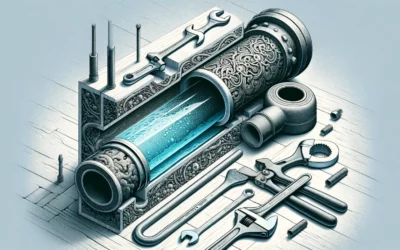Welcome to our enlightening post entitled “Mastering Water Leak Repairs in Multi-Family Buildings”. This comprehensive guide is filled with expert opinions and fact-based information aimed at equipping owners and managers of multi-family buildings with essential knowledge and skills to address water leak issues effectively. It offers practical tips and methods that have proven successful in resolving both minor leaks and major breaches. Not only can this post help mitigate the immediate damage caused by water leaks, but it can also aid in prevention, potentially saving you a fortune in repair costs and enhancing the safety and comfort of your tenants. Read on to become more proactive and adept at handling water leak repairs in your multi-family properties.
Understanding the Impact of Water Leaks in Multi-Family Buildings
Water leaks in multi-family buildings can cause numerous issues if not addressed in a timely and effective manner. Primarily, it can cause an increase in water bills, damage to building infrastructure and also lead to unhealthy living conditions. These are issues that cannot be overlooked. Thus, mastering water leak repairs is crucial in ensuring the well-being of residents and the longevity of your building.
The sequence of steps involved in the effective management of water leaks in multi-family buildings is described below, highlights the key actions that should be taken and the follow-up procedures.
- Identify the Source: This is the first and most critical step. Look for signs of water seepage, wet spots on walls or ceilings, and listen for the sound of running water when all water sources are shut off.
- Shut Off Water Supply: Once the source is identified, immediately shut off the applicable water supply to prevent further leakage and damage.
- Repair or Replace: Depending on the severity of the leak, decision should be taken to either repair or replace the faulty part. This should be done by a licensed plumber to ensure workmanship and proper follow-up.
- Inspect Surrounding Areas: After repair/replacement, inspect surrounding areas for signs of water damage and potential mold growth. If required, involve a mold remediation expert.
- Conduct Regular Inspections: To prevent future leaks, conduct regular inspections and maintenance of all water systems within the building.
| Task | Expected Time | Cost Implication |
|---|---|---|
| Identifying the Source | 1-3 hours | Minimal if DIY |
| Repair/Replacement | Depends on leak severity | $250-$500 on average |
| Post Repair Inspection | 1-2 hours | Dependent on damage extent |
In conclusion, mastering water leak repairs and water management is indispensable for all multi-family building managers and owners. Not only does it ensure the safety and well-being of residents, but it also secures the longevity and value of the building infrastructure itself.

Identifying Common Sources of Water Leaks in Apartments and Condos
In the world of property management, water leaks can swiftly transform from a minor inconvenience into a costly catastrophe if not identified and addressed promptly. While the specifics can vary depending on the individual property, we have identified several common sources of water leaks in multi-family buildings such as apartments and condos. Faulty Plumbing is one of the most prevalent contributors to water leaks. Aging infrastructure, weakened seals, and corroded pipes can all lead to leaks. Roof Leaks are another common source. Whether the result of faulty construction, aging material, or damage from severe weather, water that seeps through the roof can cause extensive damage. Other common sources include Windows, where improperly sealed or old windows can allow water to seep in. Appliances such as washing machines, dishwashers, and refrigerators can cause leaks if not properly maintained or if they malfunction.
| Source | Potential Damage | Preventive Measures |
|---|---|---|
| Faulty Plumbing | Structural damage, mold growth | Regular inspection, prompt repair |
| Roof Leaks | Damaged ceilings, insulation and electricals | Regular roof maintenance, roof replacement when necessary |
| Windows | Damage to walls and floors | Regular window sealing, timely window replacement |
| Appliances | Floor damage, electrical hazards | Regular appliance servicing, immediate cleanup of any water spillage |
Note: It’s paramount to train both your staff and tenants to spot the signs of a water leak. This can help curtail the time between when a leak occurs and when it gets fixed, thus potentially saving a sizeable amount of money in repair costs.
Mastering the Process of Detecting Water Leaks in Multi-Family Properties
Whether you’re an apartment manager or a property owner, water leaks in multi-family properties can be a detrimental issue if not addressed swiftly and correctly. Water leaks not only waste our precious resource, but also lead to significant structural damage that can often result in expensive repairs. Therefore, it is vital to understand the process of detecting water leaks at an early stage to minimize damage and maintain the integrity of the property. The Process of Detecting Water Leaks Understanding the process of detecting water leaks involves knowing the signs of a water leak, where leaks commonly occur, and the tools required for detection. The signs of a potential water leak might include:
- An unexplained increase in the water bill.
- Damp spots or discoloration on the walls or ceiling.
- Mold or mildew growth.
- A musty smell.
Leaks commonly occur in areas such as:
- Kitchen and bathroom faucets.
- Shower heads and bathtubs.
- Water heaters.
- Pipes under sinks and behind walls.
Tools typically used for detection include moisture meters, thermal imaging cameras, acoustic leak detectors, and pipe cameras.
| Detection Tool | Use |
|---|---|
| Moisture Meter | Used to measure the moisture content in the walls and ceilings. |
| Thermal Imaging Camera | Takes images based on temperature differentials, which can pick up cool spots caused by a water leak. |
| Acoustic Leak Detector | Used to identify the sound made by water leaks in pipes, even beneath the concrete. |
| Pipe Camera | Deployed to have a direct visual examination of the internal pipes. |
Make sure you’re adequately equipped, and do not hesitate to seek the help of professionals if the situation appears beyond your expertise. Detecting and addressing water leaks in multi-family properties early on is an investment in maintaining the building’s value and the welfare and satisfaction of the residents.
Effective Strategies for Handling Water Leak Repairs in Multi-Family Buildings
Water leaks in multi-family buildings often lead to damage that costs thousands of dollars in repair work. This is why it is absolutely critical for property managers to be aware of effective strategies for handling such potential disasters. As a top priority, experts recommend proactive maintenance, an initiative that includes periodic inspections and monitoring leak-prone areas. To efficiently utilize this method, use sophisticated leak detection equipment. This technique can help identify potential problems in advance, and may even be capable of detecting leaks hidden behind walls or below the floor. As part of a proactive strategy, it is vital to educate residents about the signs of water damage, encouraging them to report any suspicious instances promptly. This can significantly reduce the potential damage and save money in the long run. Another key strategy in managing water leaks in multi-family buildings is to have a clear, defined water damage response plan. This would ideally include steps to be followed in the event of a leak, including immediate actions to prevent more water from entering the area and limiting further damage. Consider the following table that summarizes effective strategies for water leaks: `< table class=’wp-table’ >StrategyActionProactive MaintenancePeriodic inspections and leak detection using sophisticated equipmentResident EducationInforming residents about signs of water damage and the importance of prompt reportingWater Damage Response PlanInitiating immediate actions upon leak detection to limit damages` Lastly, be sure to have a reliable professional contact. During emergency situations like a significant water leak, you’ll be able to save considerable time and reduce additional damage by quickly contacting a trusted plumber or water damaged restoration service. Don’t underestimate the power of a prompt and professional response to water leaks in the dynamic world of multi-family property management.
Proper Maintenance to Prevent Water Leaks in High-Rise Residences
When it comes to maintaining high-rise residences, proficient water leak prevention is of utmost importance. Most property owners are familiar with the basic maintenance requirements, but ongoing attention and advanced measures can help thwart costly and damaging water leaks. There are a few key areas to focus on to ensure your building remains dry and damage-free.
To start with, inspect and maintain your building envelope regularly. The building envelope is the barrier between the interior and exterior of your building. It includes walls, floors, roofs, doors and windows. Regular inspections can identify potential water ingress points, and preventative maintenance can nip any issues straight in the bud. Here’s what you should keep in mind:
- Keep gutters and downspouts clean: A backlog of leaves and debris can cause water to back up, leading to leaks.
- Regularly assess sealant and flashing: Damage or deterioration to these areas can allow water to infiltrate your building.
- Inspect windows and doors: Window and door-frames are common points of water entry. Regularly inspect these areas for potential vulnerability.
- Check roof membranes and surfaces: Water can seep through cracks and deteriorated areas into the building. Regular inspections can keep damage to a minimum.
Secondly, the plumbing system is a frequent perpetrator of water leaks in high-rise apartments. Regular maintenance of these systems is crucial in preventing leaks. Improvements in hi-tech detection equipment also enable efficient identification of any weak spots and leak sources before a larger problem develops.
| Plumbing system components to maintain |
|---|
| Water supply pipes |
| Drain pipes |
| Sewer lines |
| Water heaters |
| Faucets and fixtures |
In conclusion, prevention is always far more cost-effective than dealing with the fallout of a major water leak. Therefore, a comprehensive maintenance strategy for all potential points of water ingress guarantees your high-rise residence withstands the test of time and the elements.

Implementing Long-Term Solutions for Water Leak Issues in Multi-Tenant Buildings
If you’re managing a multi-tenant building, water leak issues can be particularly problematic. A poorly managed leak can cause substantial damage, not only to the affected living space but to adjacent units and the building’s overall structure. Moreover, ongoing leaks can lead to elevated utility costs and potential lawsuits if tenants’ possessions are damaged. Addressing these issues requires decisive action, and in many cases, long-term solutions rather than short-term fixes. Embrace Preventative Maintenance To effectively mitigate water leak issues, owners of multi-tenant buildings should incorporate preventative maintenanceinto their overall property management strategy. This involves conducting regular inspections of all possible areas that might be prone to leakage, such as plumbing networks, the building’s exterior, foundational structures, roofs, and gutters. Preventative checks should also extend to potential trouble spots like basements, attics, and spaces where pipe junctions occur. These places are more susceptible to wear and tear or malfunctions and, if left unattended, can culminate in significant water leakage. Have a look at the following table exemplifying a suggested schedule of regular checks:
| Area | Frequency of Checks |
|---|---|
| Plumbing Systems | Every 6 months |
| Foundation Structures | Annually |
| Roofs and Gutters | Before and after every rainy season |
Invest in High-Quality Materials and Professional Services As much as you’re inclined to manage costs by opting for cheaper materials or services, doing so can turn out to be costly in the long run. Cut-rate materials are likely to depreciate faster, leading to higher frequency of water leaks. The same logic applies to service providers: those offering services at a significantly lower cost may be cutting corners that would eventually result in shoddy work. Investing in high-quality materials and the services of professionals is essential in achieving the best results. Experienced plumbers and contractors who specialize in multi-tenant buildings will understand how best to prevent or fix water leakages, ensuring that the solution provided is tailored to your building’s needs. Remember, a well-maintained building not only saves money on expensive repairs but keeps tenants happy and retains rental value over the long term.
Future Outlook
In conclusion, mastering water leak repairs in multi-family buildings isn’t just about solving the problem at hand. It’s about proactive management, effective communication, and knowledgeable action - a holistic approach that goes beyond the physical fix and encompasses all aspects of property stewardship. By following these guidelines, property owners and managers can preserve the health of their investment, ensure the satisfaction of their tenants, and possibly even save significant resources in the long-term. Remember, water is a vital resource - but so is knowledge. Armed with a clear understanding of common water issues and how to address them, you can transform water leak mishaps from an ongoing headache into a task efficiently taken care of. Keep your buildings dry and your tenants informed, and you’ll have mastered the art of handling water leaks in multi-family structures.









